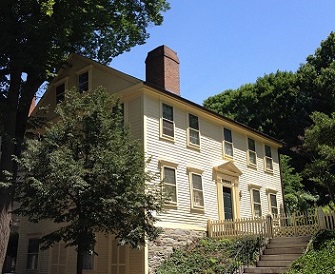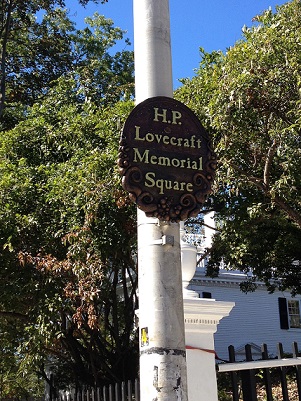Historical Characters in Works by Lovecraft

Two works by H.P. Lovecraft, “The Shunned House” and The Case of Charles Dexter Ward, are populated by various historical characters buried at the North Burial Ground. The short story “The Haunter of the Dark” also has a North Burial Ground connection. Click on a link to read more about each of these characters.
In “The Shunned House,” the narrator describes his “antiquarian uncle,” Dr. Elihu Whipple (a fictional character) as follows:
The doctor was a bachelor; a white-haired, clean-shaven, old-fashioned gentleman, and a local historian of note, who had often broken a lance with such controversial guardians of tradition as Sidney S. Rider and Thomas W. Bicknell.
Sidney S. Rider (1833-1917) was a bookseller and historian. Lovecraft uses him to underscore his description of the narrator’s uncle as a “historian of note.”
Elihu Whipple’s home in “The Shunned House” is generally believed to be based on the Benjamin Cushing, Sr. house at 40 North Court Street. Lovecraft describes Dr. Whipple’s residence as:
a Georgian homestead with knocker and iron-railed steps, balanced eerily on the steep ascent of North Court Street beside the ancient brick court and colony house.
Benjamin Cushing (1706-1785) was a furrier and hatter in Providence. He built the house in 1737, and it is one of the oldest houses in the city.
There is another historical person associated with the Shunned House who is not mentioned in the story. John Mawney (ca.1751-1830) was a physician who was one of the captors of the British revenue ship, The Gaspee, in 1772, an incident which predated and foreshadowed the American Revolution.
The “Shunned House” was most probably built by his mother, Amy Gibbs Mawney, since John owned the land but was only a teenager at the time. The Mawneys were among the few descendants of French Huguenots in Rhode Island, thus giving a tinge of believability to the French Huguenot “demoniac” ancestry claimed in the story. In 1784, Mawney sold the property to his sister Hannah’s husband, Stephen Harris (1755-1817), and Lovecraft uses the family name Harris for the fictional family who occupy the house in its early years.
Benjamin Cushing, discussed above, also has a connection to these later occupants of the “Shunned House.” His daughter, Abigail Cushing (1769-1841), was the second wife of Stephen Harris, and she occupied the house for many years.
In The Case of Charles Dexter Ward, numerous historic personages, among them the most respected 18th century citizens of Providence, are called to deal with the problems caused by the fictional Joseph Curwen. The historical characters include:
- Nicholas Brown (1729-1701)
- Joseph Brown (1733-1785)
- John Brown (1736-1803)
- Moses Brown (1738-1836)
- Gov. Stephen Hopkins (1707-1785)
- Capt. Esek Hopkins (1718-1802)
- Reverend James Manning (1738-1791)
The four Brown brothers and the two Hopkins brothers were descended from original settlers in Providence who arrived with Roger Williams in 1638. They were indeed leading lights of the town, and all of an age that would involve them, one way or another, in the years after their fictional appearance in the novel, in the American Revolution.
All four Brown brothers were traders, merchants, and businessmen. In addition, Joseph Brown was an amateur scientist and architect, and Moses, at the time of the story, was a Deputy to the Rhode Island General Assembly. The Browns would donate land (and eventually their name) for the new University (called the College of Rhode Island at the time). Its first building, University Hall, is mentioned in the novel as being under construction in 1770.

in Providence on Prospect St., not far from where
the fictional Charles Dexter Ward lived.
Stephen Hopkins was the former 10-term governor of the Colony and the then-current chief justice, while his brother, Esek, a merchant and privateer, would go on to become Commander in Chief of the Continental Navy during the American Revolution.
Rev. James Manning was first president of Brown University and first minister of the First Baptist Church.
In the novel, the Brown brothers are mentioned as the only merchants who surpassed the fictional Joseph Curwen in their imports of British goods to the town of Providence. Curwen is also said to demonstrate “civic interest” in 1765 for helping Joseph Brown, Stephen Hopkins, and others “to raise the cultural tone of the town.”
The fictional Ezra Weeden decides in 1770 to share his concerns about what he has discovered about Joseph Curwen and his clandestine activities. The Providence denizens he decides to inform include all four of the Brown brothers, Rev. Manning, and Stephen Hopkins. Lovecraft says of the Browns that they “formed the recognized local magnates, and of whom Joseph was an amateur scientist.” In December, 1770, these townspeople meet at the home of Stephen Hopkins (whose house was a favorite of Lovecraft’s, and still stands on Benefit Street) to plan their action.
Later Lovecraft describes John Brown as “the executive leader of the select group bent on Curwen’s extirpation.”
The novel has John Brown meet, in April 1771, at a local tavern with Rev. Manning, the two Hopkins brothers, and others to organize for the evening’s invasion of Curwen’s property. He describes Rev. Manning as being “without the great periwig (the largest in the Colonies) for which he was noted.” While Moses Brown did not arrive in time for the tavern meeting, he “comes up at the eleventh hour.” They all march through Providence to their destination in the Pawtuxet area of Warwick, and participate in the attack.
Afterwards, Lovecraft describes Moses Brown as being one of the most “severely hurt” in the raid, and Rev. Manning as being “the most disturbed; but even he outgrew the darkest shadow, and smothered memories in prayers.”
While she is not an actual historical character, it is worth noting that Lovecraft chose the name “Tillinghast” for Joseph Curwen’s bride, Eliza Tillinghast. The RI Historic Cemetery Commission lists 99 Tillinghasts buried at North Burial Ground, including the protagonist’s contemporary, Henry Harris Tillinghast; there are probably more.
And finally, in “The Haunter of the Dark,” Lovecraft gives his fictional protagonist, Robert Blake, rooms on “the upper floor of a venerable dwelling in a grassy court off College Street—on the crest of the great eastward hill.” This home at 66 College Street was also the place where Lovecraft himself lived during the last four years of his life. The house was originally built by Samuel Brenton Mumford (1791-1849), a commercial merchant, and has since been moved to 65 Prospect Street.
Further Reading
Lovecraft, Howard P. The Case of Charles Dexter Ward. In Tales, edited by Peter Straub. New York: The Library of America, 2005.
Lovecraft, Howard P. “The Haunter of the Dark.” In The Complete Works of H.P. Lovecraft. 2011.
Lovecraft, Howard P. “The Shunned House.” Project Gutenberg eBook #31469, 2 Mar 1910.
